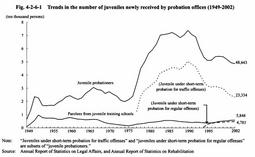| Previous Next Index Image Index Year Selection | |
|
|
2 Trends in probationary supervision cases Fig. 4-2-6-1 shows the number of juvenile probationers and parolees from juvenile training schools newly received by probation offices as probationary supervision cases since 1949.
Fig. 4-2-6-1 Trends in the number of juveniles newly received by probation offices (1949-2002) The number of juvenile probationers newly received by probation offices increased drastically from 1977 when short-term probation for traffic offenses was introduced. The number remained at around 70,000 since 1983 but decreased from 1991 until 1995. Although it slightly increased from 1996 until 1998 due to implementation of short-term probation for regular offenses introduced in 1994, it has been decreasing again since 1999. In 2002, the number declined by 767 (down 1.6%) from the previous year to 48,643. By contents of treatment, 23,334 juvenile probationers were placed under short-term probation for traffic offenses (decrease of 1,212 persons (4.9%) from the previous year), 4,783 were placed under short-term probation for regular offenses (increase of 107 persons (2.3%)), and 20,526 were placed under probation other than these (increase of 338 persons (1.7%)). The decrease in the number of juvenile probationers newly received is due to decrease in the number of juvenile probationers placed under short-term probation for traffic offenses.The number of parolees from juvenile training schools newly received by probation offices had increased until 1985 partly due to the introduction of short-term treatment in juvenile training schools in 1977. After that, it generally decreased until 1996 but has continued to increase since 1997. In 2002, the number increased by 60 persons (1.0%) from the previous year to 5,848 (see Appendix 2-13 ). |
